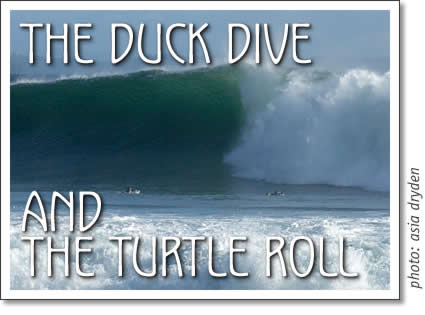
Tofino surfschool: The duck dive & the Turtle Roll
by Jayson Bowers, Tofino
 The duck dive and the turtle roll have got to be two of the hardest maneuvers to learn and perform properly in the early stages of your surfing career.
The duck dive and the turtle roll have got to be two of the hardest maneuvers to learn and perform properly in the early stages of your surfing career.
If you want to surf our coastline, especially in the winter, you will have to perfect these two maneuvers, or end up riding inside foam balls for 9 months of the year. Oh, don’t worry… you’ll have tons of time to practice on your 15 minute paddle out tomorrow.
I’ll try to keep it simple.
Duck dive; Short Board.
-
Paddling out, a wave is approaching. Keep paddling, approach the wave with speed and momentum. Without momentum the wave has the upper hand before you even try to get under it. If you can, find the weakest part of the wave to duck under; avoid the spot where the lip of the wave lands.
-
Now, about 3⁄4 of the way up your board or just in front of your shoulders, grab the rails, straighten your arms and plunge the nose and your body under the wave as deeply as you can.
-
As the wave washes over you, push your knee or your foot (preferably your foot, it does less damage to your board over time) into the tail of the board to direct the nose to the surface. Look up, open your eyes and see where you will surface.
-
With your eyes open, the surface in sight, and your foot still on the tail, Pull the board towards your chest. If you’ve done this correctly the momentum of the wave should suck you under and to the surface.
-
You now have your board under your chest. Break the surface and start paddling.
-
Repeat this as many times as it takes. You’ll probably lose count!
Turtle roll: Long Board.
Long boards are a great addition to any quiver, but getting them out can be a humbling mission. Because the boards are so big and buoyant, a duck dive is next to impossible. A turtle roll is the next best thing. The idea is to get under the board and let the wave pass over you. Before you attempt this make sure there is no one behind you incase the board gets ripped from your hands.
-
Paddle as hard as you can. Momentum.
-
With the wave starting to break about 3 seconds in front of you, Tightly grab the rails near the nose. Holding the board, flip your body into the water so the board is on the surface and you’re under it.
-
Wrap your legs over it or clench the rails with your knees and pull the nose of the board further underwater. This will allow the wave to flow over the board without going under and ripping it out of your hands.
-
You’re set up; hold on and let the wave pass over you.
-
Once the wave passes, let go of your board and surface. Flip your board over. Pull yourself back up and start to paddle. You should be out in no time.
As with any thing with this sport, it takes a lot of practice, but without the duck dive or the Ole’ turtle roll, you won’t be going any where near the line up any time soon. One of the worst things you can do is ditch your board to swim under the wave. Not only will you eventually bring harm to some one and ruin their session or their new board but will also cut your surf session in half by the amount of energy you spend chucking your board and trying to get back on it, time and time again.
Jay Bowers is a surf instructor and runs Pacific
Surf School in Tofino. You can reach him by email at info@pacificsurfschool.com
Tofino Surfing Articles
- Queen of the Peak women surf comp Oct. 2010
- O'Neill CWC 2010: Re-Pete Devries? Oct. 2010
- Peter Devries - a True Champion Nov. 2009
- Surf Canada May 2002
- Surf: Winter Swells Oct. 2002
- Surf Sister Surf Trip Apr. 2004
- Surfgear for Beginners Feb.2003
- Surfing Etiquette Jun.2002
- Surfing Etiquette Feb 2004
- Tofino Skatepark! Oct. 2003
- Tofino Surf Gear: Pump up the Volume Feb 2011
- Tofino Surfing: Backside Air Sep.2003
- Tofino Surfing: Backside Bottom Turn Apr.2003
- Tofino Surfing: Backside Reentry Sep.2004
- Tofino Surfing: Backside Roundhouse July 2004
- Tofino Surfing Backside Straight up Aug. 2009
- Tofino Surfing: Backside Wave Speed Oct. 2003
- Tofino Surfing: Frontside Air Nov. 2003
- Tofino Surfing: Frontside Air Reverse Jan.2004
- Tofino Surfing: Frontside off the lip Jan. 2005
- Tofino Surfing: Frontside Cutback Jan. 2003
- Tofino Surfing: Frontside Floaters Dec. 2003
- Tofino Surfing: Layback Snap June 2004
- Tofino Surfing: Generating Speed Dec.2002
- Tofino Surfing: How to not Die May 2005
- Tofino Surfing: Pumping on a Frontside Wave Mar. 2007
- Tofino Surfing: Surfing Etiquette July 2006
- Tofino Surf: Surf Jam 2004 June 2004
- Tofino Surf: Surf Jam 2004 July 2004
- Tofino surfing: To go... or not to go... June 2009
- Tofino surfing: Winter swells... Nov. 2009
- Tofino surf school: Duck Dive & Turtle Roll Dec. 2009
- Yoga for Men Jan.2005
- Yoga for Surfers Sep. 2004
tofino | tofino time | activities | accommodation | events | directory
maps | travel | food | art & artists | photos | horoscope | tides
search | magazine | issues | articles | advertising | contact us
hosted in tofino by tofino.net & studio tofino
© 2002-2014 copyright Tofino Time Magazine in Tofino Canada
Tofino in December 2009: An overview of what's happening this month in Tofino, compiled by Adam Buskard for Tofino Time Magazine.

quick links:
- tofino accomodations
- tofino calendar
- tofino surf report
- tofino horoscope
- march horoscope
- tofino map
- tofino fishing report
- tofino tides
- tofino weddings
tofino events:
- tofino concerts
- tofino events
- tofino movies
- tofino festivals
- tofino yoga classes
- tofino whale festival
tofino time magazine:
- tofino time march 2016
- tofino event listings march 2016
- tofino concerts in march 2016
- tofino movies in march 2016
- cox bay | wickaninnish beach
- chesterman beach
- tonquin beach
- tofino brewing co.
- tofino wedding guide
tofino accommodation:
- tofino cabin
- tofino camping
- bed & breakfasts in Tofino
- tofino hostels
- tofino motels
- tofino hotels
- tofino vacation rentals
- petfriendly accommodation
activities:
- tofino bike rentals
- tofino bear watching
- tofino bird watching
- tofino boat charters & cruises
- tofino fishing
- hot springs cove
- sea kayaking in tofino
- tofino storm watching
- tofino surfing
- tofino whale watching
- tofino yoga
shopping:
services:
- tofino yoga, spa & wellness
- tofino restaurants
- tofino internet cafes
- tofino travel & transportation
- tofino real estate
- tofino taxi services
- tofino wedding & events
